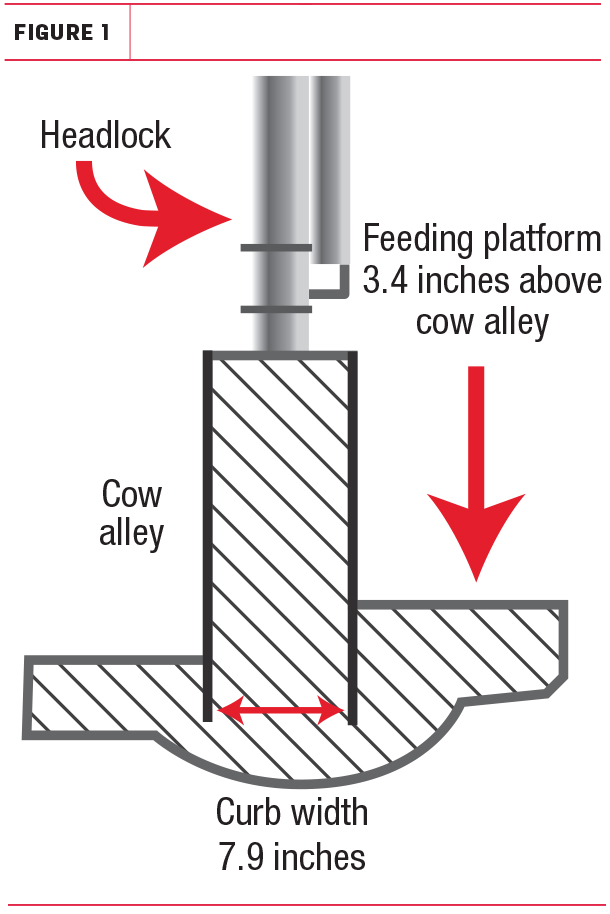Headlocks are a versatile feed front solution for any farm; they give any farm manager who walks on-site the ability to choose the management style that works for them.
Whether they want to treat their herd in the treatment area or at the feedbunk, they are free to do what works best for them.
It’s important to choose a long-lasting solution because the value of your headlocks is part of a long-term investment in your facility. They are designed to help you streamline work and reduce your labor requirements over a 10- to 15-year period.
For that reason, choosing the right headlock for each age group is critical, but it’s also important to note headlocks are just one part of creating an inviting space for animals to feed.
All feeding areas should:
- Ensure easy and comfortable access to feed
- Limit feed wastage
- Provide a safe environment that won’t lead to injury
- Make feeding out easy for farm staff
These four critical elements of feedbunk design are necessary to ensure the highest long-term return on investment. So what goes into creating a comfortable, safe, easy-access feedbunk that minimizes feed waste and simplifies feeding out for your staff?
The importance of grazing
In grazing cows, the point of the shoulder tips forward in front of the hooves to enable the cow’s mouth to reach the ground. In this grazing stance, cows produce 15 to 20 percent more saliva than cows eating horizontally.
The production of saliva helps maintain good rumen function and limits feed wastage, as they are less likely to toss feed or practice other wasting behaviors.
A properly designed feeding area will allow you to conveniently deliver the ration and easily clean while providing enough space for the cows to consume an adequate amount of feed without hindering their natural grazing position.
Fundamentals of curb design
Curb design will be dependent on the age group you are building for, but it should be 7.9 inches in width to support headlocks (Figure 1).

The height of the cow side must not be too high to put pressure on the bottom of the throat or neck when the age group you are working with is in a normal eating position.
On the feeding platform side, the eating surface should be 3.94 inches above the cow alleyway. The surface needs to be a non-porous, easy-to-clean material 31.5 to 35.4 inches wide with a 1 to 2 percent slope to the center of the feed alley.
Getting the curb width and feed table height right will ensure feed isn’t pushed away by cows trying to eat. It minimizes the risk of wastage and reduces the frequency of “push-up.” It also ensures good muscular action and ensures optimal salivary production.
Critical component: Bunk space
Arguably one of the most important factors, having “ample” bunk space per animal will reduce competition at the feedbunk and promote good feed intake. Regardless of whether you are working with headlocks or feed rails, all cows need plenty of room.
Headlock sizing and curb dimensions
There are three key dimensions to keep in mind when choosing headlocks for the different age groups within your facility. The height of the neck rail (or top pipe), the size of the headlock opening and the curb height will increase as your heifers grow.
All of these need to be sized appropriately to be comfortable enough animals can reach the bunk floor without throat discomfort. If they can’t, it will affect the volume of feed your cows can reach and eat.
For animals aged zero to 3 months, we recommend using a sloped feed rail or V-trainer to teach them to put their heads in at shoulder height and then drop down to eat. Going through this training process acclimatizes them to this process and will ensure fewer refusals when you transition them to headlocks.
For animals 3 to 6 months or 250 to 410 pounds, you should aim for eight openings in 10 feet with a shoulder height of 37 to 41 inches. The cow lane should be 12 inches high, and your feed lane should be 8 inches. The total feed front system, including the curb, should be 45 inches high.
When your herd reaches 6 to 9 months or 410 to 590 pounds, you should move to seven openings in 10 feet with a shoulder height of 41 to 45 inches. Your cow lane should be 14 inches, and the feed lane should be 10 inches high. The total feed front system height, including the curb, should be 49 inches.
For cows 9 to 20 months ranging from 590 to 1,190 pounds, you should have six openings in every 10-foot section. Cow lanes should be 16 inches with feed lanes 12 inches high, and the total system including the curb should be 55 inches.
For cows 20 to 24 months and adult cows ranging from 1,190 to 1,600 pounds, we recommend five openings in 10 feet. The cow lane should be 18 inches, and the feed lane should be 14 inches with a total system height of 60 inches including the curb.
Designing an inviting, functional, safe feed front isn’t tricky.
It’s crucial when choosing headlocks to take into account the largest animal in the group and design a facility that steps up in size as heifers grow.
Cows should be able to fit their heads through the headlock opening comfortably without a lot of twisting or maneuvering. When closed, the headlock should not place unnecessary pressure on the heifer’s neck, and it’s important to choose a headlock with a safety-release mechanism that releases a heifer if it slips and falls during lockup.
The rest comes down to designing your facility in such a way you minimize waste and labor requirements at the same time you encourage the natural cow behaviors that will ultimately increase production and reduce health issues in your herd. Long story short, it’s about designing your facility with cow comfort and efficient management in mind. ![]()
PHOTO: Correct curb width and feed table height ensures feed isn’t pushed away by cows trying to eat, thus minimizing the risk of wastage and reducing frequency of push-ups. Courtsey photo.

-
Sue Hagenson
- Senior Dairy Specialist
- Artex Barn Solutions
- Email Sue Hagenson






